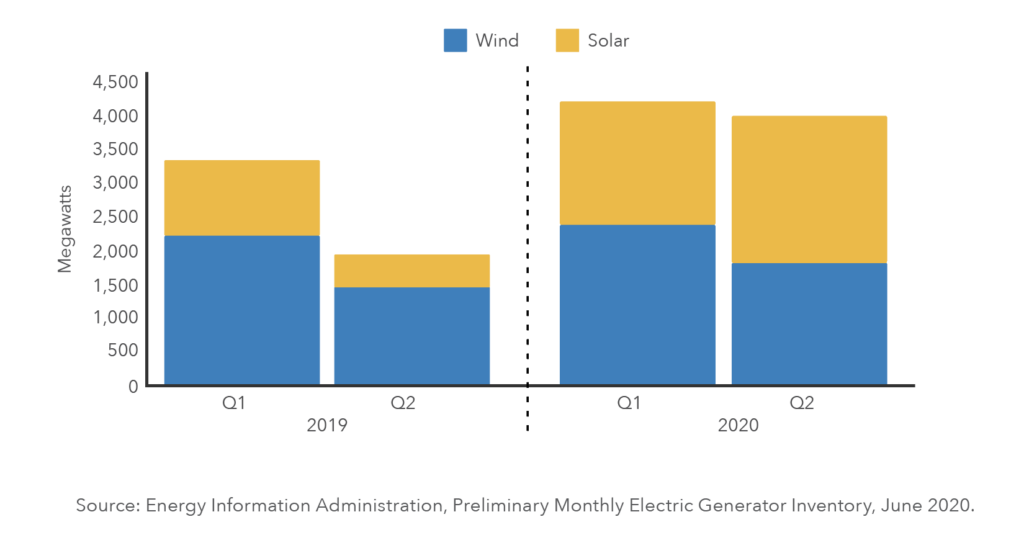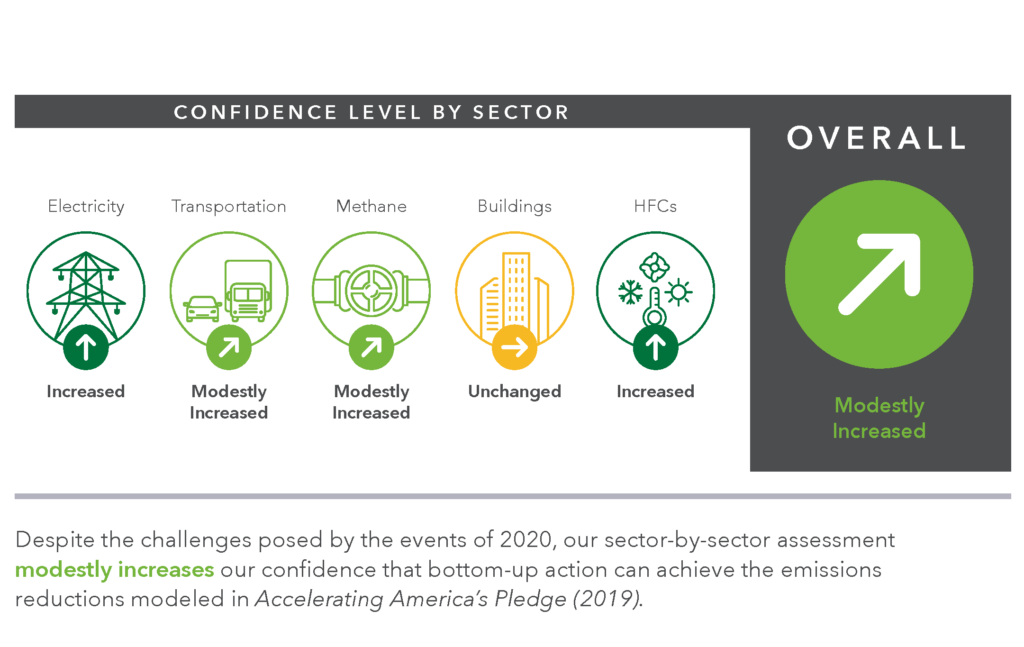
In spite of a global pandemic and the worst economic conditions in nearly a century, U.S. states, cities and businesses are continuing to lead the fight against climate change.
A new report by America’s Pledge provides crucial evidence that state and local governments and the private sector are pushing forward on climate action, while broader market shifts are accelerating the transition to clean energy. Delivering on America’s Pledge: Achieving Climate Progress in 2020 examines five sectors – covering 75% of U.S. greenhouse gas emissions – and assesses how the COVID-19 pandemic and economic downturn have impacted the ability of the United States to achieve 2030 climate objectives.
The report provides an updated assessment of how recent trends may have altered emissions reduction potential modeled last year in Accelerating America’s Pledge. The 2019 report found that expanded action by states, cities and businesses could reduce U.S. greenhouse gas emissions 37% below 2005 levels by 2030. With a positively engaged federal government, those reductions could reach 49%. The report further found that achieving this ambitious level of emissions reduction would require accelerated market transformation and significant social and political mobilization around climate action.
Through sector-by-sector evaluation of key trends and drivers, the new report finds that despite the unprecedented public health and economic crisis, bottom-up climate action is proving resilient. On the whole, the findings modestly increase confidence in emissions reduction potential over the next decade.
1. Shifting to Clean Electricity
In the electricity sector, recent trends are reinforcing the longer-term shift to clean sources. Reduced electricity demand, as a result of the pandemic shutting down large parts of the U.S. economy, has increased economic pressure on coal generation and accelerated the retirement of coal power plants, speeding progress toward deeper power sector emissions reduction. Between January and June 2020, the Energy Information Administration’s monthly tally of planned coal retirements beginning in 2021 increased by more than 13 GW.
At the same time, the long-term drivers of renewable energy investment remain strong. The renewable energy industry appears to be weathering the crisis well, particularly utility-scale wind and solar power. In April-June 2020, the deepest part of the lockdown, the United States added 4 GW of utility-scale wind and solar capacity, compared to 1.9 GW during the same period last year.

While the pandemic has slowed some clean energy legislation, many states, cities and businesses reaffirmed their support for clean electricity policy. One example is Virginia’s Clean Economy Act, which requires the state to transition to 100% carbon-free or renewable energy by 2050. Virginia is now the eighth state in the nation and the first in the South to require 100% clean electricity.
2. Reducing Transportation Emissions
Trends in the transportation sector also provide assurance that 2030 emissions reduction goals are likely to be met. While still uncertain, the increase in remote working during the pandemic may have lasting effects on commuter travel by car, with potential for long-term reduction in miles driven.
This year has seen significant progress toward vehicle electrification, with accelerated commitments to address emissions from medium- and heavy-duty vehicles in particular. In March, Washington adopted California’s ZEV rule, requiring automakers to achieve a 6% zero-emissions vehicle (ZEV) sales threshold as a share of total automobile sales beginning in 2022. In June, California led the way again by adopting the Advanced Clean Trucks rule, and in July, 15 states and the District of Columbia set a target for all new medium- and heavy-duty vehicle sales to be zero-emission vehicles by 2050, with 30% ZEV sales by 2030. Meanwhile, The Western Governors’ Association launched the Electric Vehicles Roadmap Initiative, which seeks an expanded regional agreement on EV charging infrastructure.
On the other hand, many public transit authorities are facing a sharp decline in ridership and a projected annual budget shortfall as a result of the pandemic. Public transit will require significant support in upcoming economic recovery and stimulus packages to restore and maintain services.
3. Stopping Methane Leaks
Methane leaks from oil and gas operations have been a growing source of potent greenhouse gas emissions in recent years. However, recent price shocks, coupled with a reduced long-term demand outlook for oil (due to accelerated electric vehicle investment), appear likely to limit or reverse this trend moving forward.
In the first quarter of 2020 alone, publicly traded U.S. oil producers wrote down at least $48 billion in assets, and growth projections for both the oil and gas industry are now significantly lower than anticipated in the 2019 America’s Pledge analysis. These trends reduce the potential for new infrastructure buildout and associated new methane emissions over the next decade.
On the regulatory front, policy progress to reduce methane emissions from existing infrastructure continues in key states such as Colorado, Pennsylvania and New Mexico, even while federal efforts to roll back industry-wide regulations continue. In addition, leakage appears to be rising from existing infrastructure as operators in the United States face financial strain. However, these risk factors and uncertainties are outweighed by diminished industry growth potential and long-term policy trends that remain positive on the whole.
4. Electrified, Efficient Buildings
Recent trends in building electrification and efficiency show that 2030 emissions reductions goals are still on course, despite the COVID-19 pandemic temporarily stalling some efforts. Some states have proposed diverting funds from energy efficiency programs toward household bill assistance funds. Others, however, including New York and Michigan, are increasing funding for both efficiency programs and energy assistance for low-income households in order to ease high energy bills and soften the blow of the economic downturn.
The pandemic has also triggered major disruptions in consumer behavior and energy demand, though these trends’ impact on long-term decarbonization is less clear. According to EIA data, in the early months of the crisis, commercial electricity consumption fell dramatically, residential demand rose slightly and overall building energy consumption was down compared to the same period last year. While significant in the short term, these trends appear to be ephemeral and less likely to impact the 2030 emissions trajectory, leaving confidence unchanged.
5. Regulating HFCs

State efforts to reduce emissions of hydrofluorocarbons (HFCs) – another potent greenhouse gas used in refrigeration and air conditioning – have continued during the pandemic. Five new states proposed or enacted policies in 2020, bringing the total to 16 and counting. This state action countered rollbacks of federal HFC regulations and has broadened support for federal policy to address HFCs, such as the legislation under the recently advanced bipartisan American Energy Innovation Act.
Need For Federal Climate Leadership
Despite the significant progress made by states, cities and businesses, this is not a moment for complacency. Ambitious emissions reduction will require significant effort on the part of the federal government in order to achieve deep decarbonization at the speed and scale required.
Federal economic recovery and stimulus packages can provide a critical opportunity to not only maintain momentum, but ratchet up ambition by state and local governments. Without stimulus, progress on climate action could slow and hamper the ability of the United States to achieve crucial 2030 emissions reductions.
Major opportunities exist for stimulus and recovery policies across sectors that can not only address climate change, but also create jobs, strengthen the economy, improve public health and improve economic and racial equity. Financial incentives for renewable energy, energy storage and public transit will provide much-needed infrastructure while creating jobs and spurring economic activity. For instance, every $1 billion invested in public transit has the potential to create nearly 50,000 jobs and return $5 billion in economic activity. Providing funds to continue weatherization and energy efficiency programs that prioritize low-income housing will offer families relief from high energy bills. Tax incentives would allow the HVAC industry to provide essential maintenance and upgrades to existing air conditioning and ventilation systems, which are the first line of defense against the spread of airborne diseases such as COVID-19.
This report comes at a time of unprecedented uncertainty about the health, safety and resilience of the planet. The actions taken by U.S. cities, states and industry in the midst of this uncertainty show that their determination to fight climate change is undeterred.
The choice that the United States – and every nation – faces is whether to use this opportunity to build back better and create a cleaner, more prosperous and more resilient economy. To miss this opportunity would be to squander a chance to deliver on America’s Pledge and provide a more secure future for all.
America’s Pledge is a collaborative effort between the leadership of the America’s Pledge initiative and a core research team including University of Maryland, Rocky Mountain Institute, WRI and other partner organizations.
This blog originally appeared on WRI’s Insights.
John Feldmann is a Research Analyst for World Resources Institute, United States.
Tom Cyrs is a Research Associate for World Resources Institute, United States.
Devashree Saha is a Senior Associate for World Resources Institute, United States.





